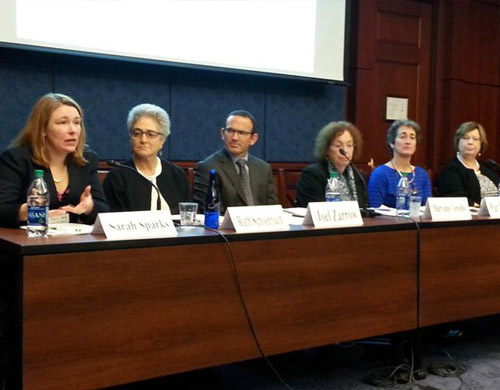In ancient Sparta, when a young man finished his military training, the city elders held a ceremony in which they removed a stone from the city wall. The idea was that the defense of Sparta was in its people, not its walls.
Just a few days ago, I was privileged to witness an event in which five more programs funded by the Investing in Innovation (i3) program presented their methods and findings on Capitol Hill. Our government might have used this as an opportunity to remove some of the walls that impede progress in education. As more and more programs demonstrate that they can reliably improve student achievement in high-poverty schools, can we slowly back away from the idea that evidence has little role to play in educational policy? Not all of the programs supported by i3, the Institute of Education Sciences (IES), and other funders, are achieving immediate positive outcomes in comparison to control groups, though they may do so in the future. But based just on the programs we know to be effective, why can't we begin to base educational policies on what works while simultaneously continuing to build up our army of proven approaches?
The findings from the first set of programs funded by i3 are starting to become available. As most readers of this blog know, i3 provides grants according to the levels of evidence programs already have. In 2010, scale-up proposals had to have strong, replicated evidence of effectiveness, and could receive up to $50 million over 5 years. Validation grants needed at least one supportive study, and could receive up to $30 million, and development grants needed only a good idea, and could receive up to $5 million.
Not surprisingly, all four of the 2010 scale-up grants found positive effects in rigorous third-party evaluations. These programs - Reading Recovery, Teach for America, KIPP, and our own Success for All - reported on their impacts in a briefing on Capitol Hill in September, 2014. This year, a new crop of validation and development grantees had good news to share, and did so in a Capitol Hill briefing on October 29. Sarah Sparks of Education Week served as moderator. The Annie E. Casey Foundation, represented by Ilene Berman, funded the session.
Five programs were presented. Ruth Schoenbach of WestEd spoke for Reading Apprenticeship Improving Secondary Literacy (RAISE), which provides professional development for high school and middle school content teachers (e.g., science, history, English) to help them engage students in productive ways of engaging with text.
Nancy Brynelson, of the California State University system, described the Expository Reading and Writing Course (ERWC), an approach used in 800 high schools across California to attempt to reduce the number of students who need remedial literacy courses when they go on to post-secondary education. Like RAISE, ERWC provides professional development to high school teachers to help them help students to engage deeply with text, using discussions, extended writing, and development of critical thinking skills.
Building Assets Reducing Risks (BARR) also focuses on high schools, but uses a very different approach. Represented at the briefing by its evaluator, Dr. Maryann Corsello, BARR focuses on social-emotional as well as academic learning. It provides professional development to teachers focused on building relationships among students and staff, effective communication, and risk reviews for low-performing students.
Two of the programs focused on early reading. The Children's Literacy Initiative (CLI), represented by Joel Zarrow, works in grades pre-K to 3 in high-poverty schools. The program provides one-to-one coaching to teachers, as well as group and leadership coaching, to help teachers with creating and managing the learning environment, using data to guide instruction, and using best practices for early literacy.
SPARK is a tutoring program for grades K-3 that is provided by Boys & Girls Clubs of Greater Milwaukee. Pat Marcus spoke for the program. It provides one-to-one tutoring for struggling readers, primarily using AmeriCorps members. The tutoring strategies are patterned on those of Reading Recovery, an i3 scale-up program used nationally. The SPARK model also includes a family engagement component to increase parents' skills in supporting their children's education.
It was wonderful to learn about each of the five programs, but to me, it was particularly exciting to reflect on the larger message: Investing in Innovation is doing what it was intended to do. Every one of the programs at the briefing had been evaluated by third-party evaluators and found to be effective in rigorous experiments. The programs were highly diverse in approaches and intentions, but each adds significantly to our armamentarium of effective models, ready to serve large numbers of students throughout the U.S. Add the proven i3 scale-up programs and many more i3 programs sure to produce similar impacts, not to mention many more already proven programs being funded by other sources, as well as many sure to be proven effective in the next few years, and you can see the potential for dramatic change in how we collectively improve educational outcomes.
The i3 process has had a huge impact on our understanding of educational change. Programs that have shown positive impacts provide solutions that are ready to go. Those that did not are sure to be a majority (in all areas of evidence-based research, most experiments do not show positive effects). However, a great deal is being learned from those studies as well, and the entire field is moving forward at a pace once thought unimaginable. The recent Hill briefing is the second of what I am sure will be many celebrations of proven programs for an ever-expanding set of subjects, grade levels, and situations.
As we gain confidence in each of these approaches, I hope we can learn to rely on our people, our ingenuity, and our science to improve our schools. Like the Spartans of long ago, let's recognize that these are the essential assets for our security and our progress.

